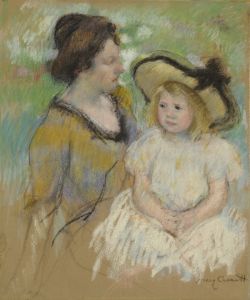
Medea with her Younger Son Sleeping in her Arms
A hand-painted replica of Anselm Feuerbach’s masterpiece Medea with her Younger Son Sleeping in her Arms, meticulously crafted by professional artists to capture the true essence of the original. Each piece is created with museum-quality canvas and rare mineral pigments, carefully painted by experienced artists with delicate brushstrokes and rich, layered colors to perfectly recreate the texture of the original artwork. Unlike machine-printed reproductions, this hand-painted version brings the painting to life, infused with the artist’s emotions and skill in every stroke. Whether for personal collection or home decoration, it instantly elevates the artistic atmosphere of any space.
Anselm Feuerbach's painting "Medea with her Younger Son Sleeping in her Arms" is a notable work of art that reflects the artist's engagement with classical themes and his mastery of the academic style. Created in 1870, this painting is part of Feuerbach's exploration of mythological subjects, a common theme in his oeuvre. Feuerbach, a German painter, was one of the leading figures of the 19th-century German art scene and was known for his classical approach and his focus on historical and mythological subjects.
The painting depicts the tragic figure of Medea, a character from Greek mythology, who is often portrayed as a powerful and complex woman. In this particular work, Medea is shown holding her younger son, who is peacefully sleeping in her arms. The composition is intimate and poignant, capturing a moment of calm before the storm of tragedy that is central to Medea's story. Feuerbach's portrayal of Medea is marked by a sense of melancholy and introspection, which is emphasized by the subdued color palette and the gentle rendering of the figures.
Feuerbach's interest in classical antiquity is evident in his choice of subject matter. Medea, a sorceress and the wife of Jason, is a character from the ancient Greek play "Medea" by Euripides. Her story is one of love, betrayal, and revenge, culminating in the murder of her own children. Feuerbach's depiction of Medea with her son highlights the duality of her character as both a loving mother and a figure capable of extreme actions. This duality is a central theme in many interpretations of Medea's story and is skillfully captured by Feuerbach in this painting.
The painting is characterized by its academic style, which was typical of Feuerbach's work. He was influenced by the classical traditions of the Renaissance and the Baroque periods, and his paintings often reflect a careful study of form, composition, and color. In "Medea with her Younger Son Sleeping in her Arms," Feuerbach employs a balanced composition, with Medea positioned centrally, drawing the viewer's attention to her serene yet contemplative expression. The use of light and shadow adds depth to the painting, enhancing the emotional impact of the scene.
Feuerbach's work was highly regarded during his lifetime, and he was considered one of the foremost painters of his generation. His paintings were appreciated for their technical skill and their ability to convey complex emotional narratives. "Medea with her Younger Son Sleeping in her Arms" is a testament to Feuerbach's ability to blend classical themes with a personal, emotional depth, making it a significant piece in the study of 19th-century art.
Today, Anselm Feuerbach's paintings, including "Medea with her Younger Son Sleeping in her Arms," are held in high esteem and can be found in various art collections and museums. His work continues to be studied for its contribution to the academic art tradition and its exploration of timeless themes from classical mythology.


















